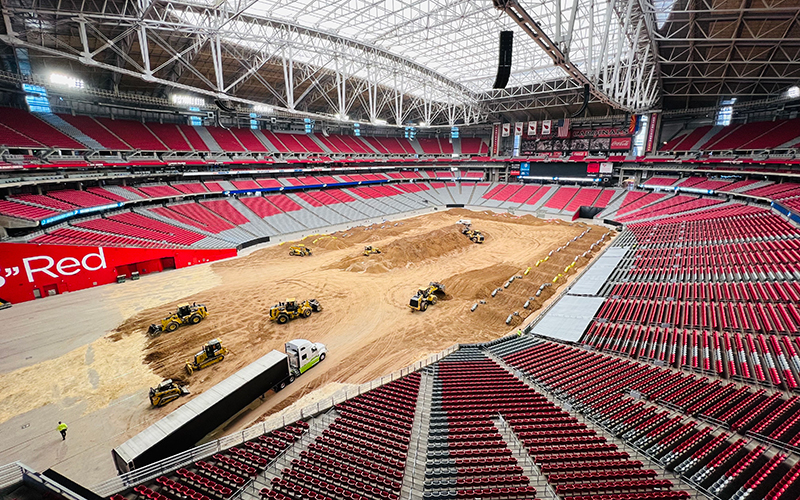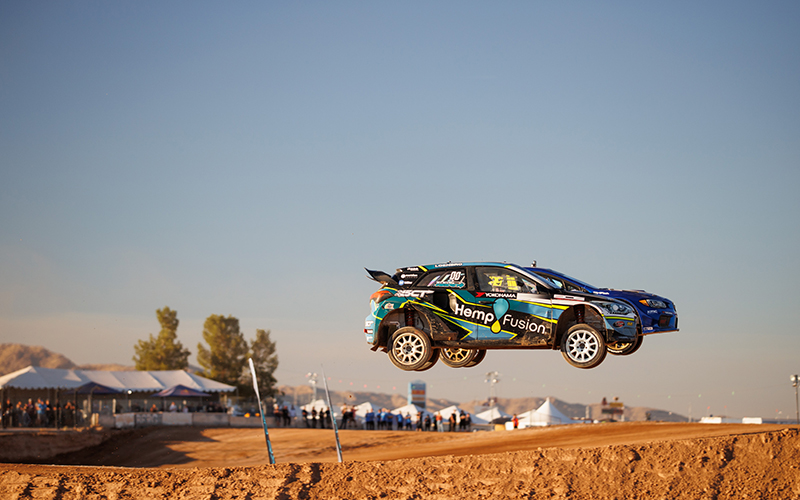

It took three days and dump trucks filled with dirt 400 times, but the track for the Monster Energy AMA Supercross Championship at State Farm Stadium transformed from a simple surface with mounds of dirt to a complicated track with obstacles and jumps. (Photos by Andrew Kurland/Cronkite News)
GLENDALE – Four days before State Farm Stadium hosted the Monster Energy AMA Supercross Championship for the first time in two years, dirt was still being brought onto the stadium floor.
Three days and 400 dump trucks of dirt covering 6,500 cubic yards later, a unique masterpiece was finished and on display.
Saturday’s track was unlike any layout seen in previous events in Glendale. The track featured a split starting gate, which gave way to a 510 foot straightaway leading into the holeshot.
Supercross, an indoor dirt-bike racing sport which evolved from motocross, is conducted on specifically built indoor dirt tracks and involves jumps and obstacles. Each round of the Monster Energy AMA Supercross Championship is designed to feature unique layouts, even when putting on multiple rounds in the same stadium.
Drivers are used to having to prepare quickly for different layouts. This year’s series is in the midst of a season-opening run of 12 consecutive Saturdays. The visit to Glendale marked the fifth Saturday in that run. The event lands in Anaheim, California, this weekend.
At least the drivers do not come into a stadium completely in the dark.
Chris Blose, a veteran 250SX class driver from Phoenix, said track maps for an entire season are made available about a month before the season starts.
The experience can help preparations.
“You kind of have an idea with how the dirt breaks down if you’ve been to the stadium before, so you kind of have a rough idea of what the rhythm section and stuff like that will be,” Blose said.
When the riders make their way into a particular venue, they know there is an urgency to pick up any information they can about the layout that is presented before them.
“We have to learn the track right away and that’s kind of what we do,” said Cooper Webb, the defending 450SX class Supercross champion.
In Glendale, that preparation started the day before any racing took place. Select riders got to ride through a portion of the track during media day activities the day before the race.
Only then did the drivers got to see the track maps come to life.
“When you get in the stadium, then you finally see how steep it is in the real design of the tracks,” Marvin Musquin, Webb’s teammate, said.
One of the areas that received plenty of attention was the split starting gate.
“It’s something different that we don’t normally see,” Webb said. “They got a big tunnel, which is pretty cool.”
Plenty of drivers took the opportunity to walk along different sections of the track. In some motorsports, this may sound tedious. However, Supercross presents a much different challenge.
Seven different obstacles make up each Supercross track, not including the starting gate. They range from a triple jump that riders can clear with plenty of air time to sections of sand designed to slow riders down.
There’s one obstacle in particular that Webb said is key to figuring out how a driver wants to run a particular race.
“Usually we call it the rhythm sections with all of the jumps, trying to figure out what combination we’re going to do through those,” Webb said.
Obstacles alone, though, are not the only factor in how a track will run. The dirt itself can also play a role. Similar to the different layouts run in the series, each round’s surface is also unique.
Each city in Supercross has its own dirt, said Bill Heras, AMA Supercross tour manager. The dirt is stored in a stockpile near a particular stadium until the series is ready to come and race.
Blose said the type of dirt that is used makes a big difference in how familiar one is with a particular track.
“It’s just like I grew up riding on, so I’m obviously super comfortable on it,” Blose said about Glendale’s dirt surface. “Then, when I go back east in Georgia, it’s like I’m a fish out of water because it takes me a little bit to get used to it.”
Once drivers get a feel for a track’s surface, any and all types of adjustments can be made.
“With the settings, we need to adapt sometimes,” Musquin said. “Sometimes, they will work out what we have, but sometimes we have to adjust the settings and all the tires. Different kinds of tire or tire pressure, for example, and obviously suspensions and maybe some engine settings.”
When it’s time to race, drivers get a sighting lap, providing one last opportunity to get a feel for the track. The drivers look for preferred lines to run in this lap, particularly in turns where lines are grooved in.
For the drivers who take top honors, as Eli Tomac and Hunter Lawrence did on Saturday in the 450SX and 250SX classes, respectively, all of the preparation on a track’s layout and dirt surface becomes worth the effort.


